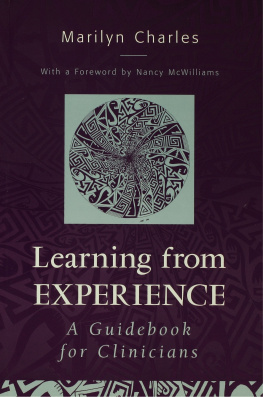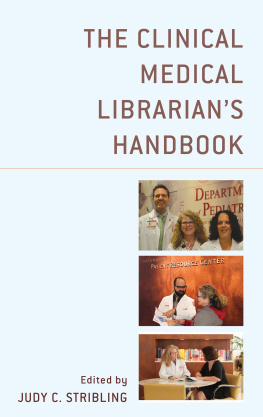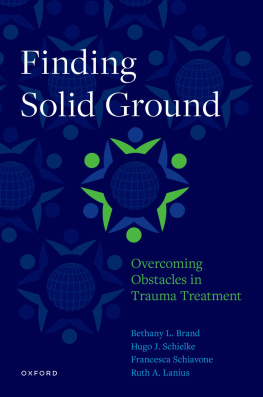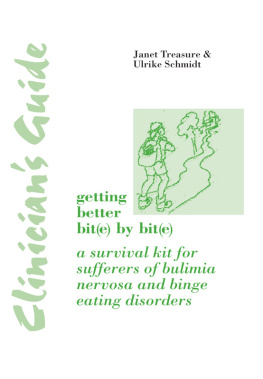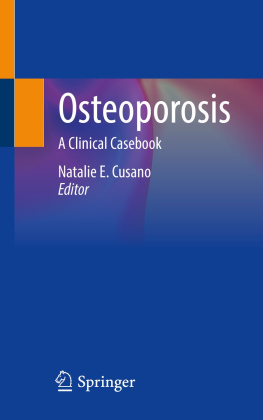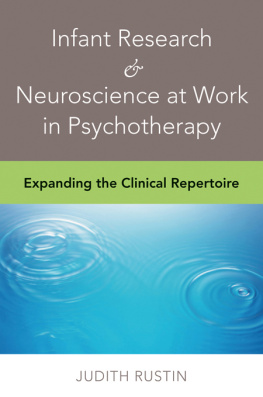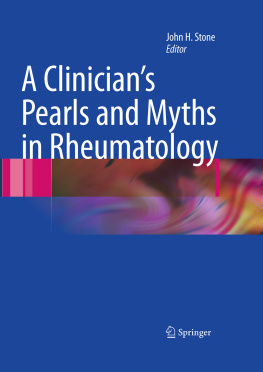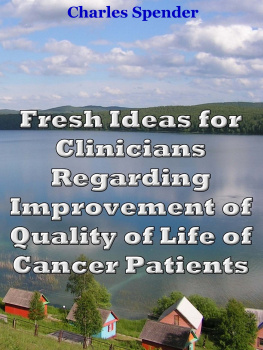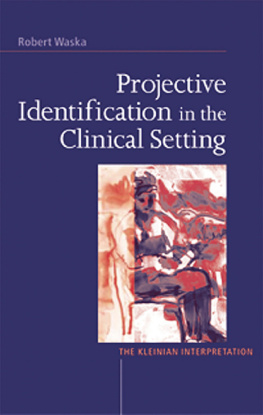LEARNING
FROM
EXPERIENCE
Learning From Experience
A Guidebook For Clinicians
Marilyn Charles
With a Foreword by Nancy McWilliams
2004 by The Analytic Press, Inc., Publishers
All rights reserved. No part of this book may be reproduced in any form: by photostat, microform, retrieval system, or any other means, without the prior written permission of the publisher.
Published by
The Analytic Press, Inc., Publishers
Editorial Offices:
101 West Street
Hillsdale, NJ 07642
www.analyticpress.com
Designed and typeset by Compudesign, Charlottesville, VA.
Library of Congress Cataloging-in-Publication Data
Charles, Marilyn.
Learning from experience: a guidebook for clinicians / Marilyn Charles.
p.; cm.
Includes bibliographical references and index.
ISBN 0-88163-410-7
1. Psychoanalysis. 2. PsychoanalysisVocational guidance.
3. Psychotherapist and patient. I. Title.
[DNLM: 1. Psychoanalytic Therapy. 2. Psychotherapeutic Processes.
WM 460.6 C476L 2004]
RC504.C48 2004
150.19'5dc22
2004046150
Printed in the United States of America
10 9 8 7 6 5 4 3 2
Contents
IN LEARNING FROM EXPERIENCE, Marilyn Charles has written a meditation on emotional growth, on coming to know and be one's full self, that embodies as well as describes its subject. There are many good texts on how to do psychoanalytic therapy and how to understand what happens in psychoanalytic therapy. But there are very few that bring the reader so intimately inside the experience of both therapist and patient, that capture the music as well as the words of the therapeutic project. Charles maintains an unprecedented level of empathy with her readers. Inviting the beginning therapist to feel the nuances of an art that stubbornly resists reduction, she demystifies the mysterious without profaning the mystery. She interprets not only theory but also the process and value of theory-making. With unusual grace and unwavering respect for both parties to the therapeutic collaboration, Charles brings both the torments and the joys of clinical experience to life. Rich examples elucidate the wisdom of Bion, Klein, Winnicott, Lacan, and other prophetic voices in psychoanalysis. And she keeps her focus on the task at hand: nourishing the capacity of the developing therapist to engage in the kind of intimacy that fosters genuineness and growth in another person and also in the self.
I have been particularly struck by the relevance of Charles's chapter organization to the questions most commonly asked these days by therapists in training. The conventional, ego-psychology-generated parsing of psychoanalytic clinical knowledge into categories such as the working alliance, resistance, transference, countertransference, working through, and termination has become rather distant from the bedrock questions about being, feeling, and knowing that assail the newer therapist. Contemporary patients seldom look like the "neurotics" of an earlier era. They are more likely to come to treatment with problems in feeling alive, regulating affect, and staying honest, miseries that Westen has aptly called "cancers of the soul." They radiate desperation. Topics such as the role of theory, the container and contained, the schizoid and depressive positions, transitional space, truth and lies, and expanding a space for play speak far more pointedly to the urgent needs of current practitioners than an earlier psychoanalytic language which assumed a self that could observe its problematic components.
Contemporary students of psychoanalytic therapy are confronted with a bewildering barrage of theoretical models and therapeutic metaphors. If they are exposed to psychoanalytic thinking in graduate school or medical trainingand increasingly, they are not, given the ascendancy of cognitive-behavioral paradigms in psychology and biological models in psychiatrythe emphasis is likely to be on the short-term, symptom-targeted, empirically researched psychodynamic approaches. If they become attracted (usually as a result of their personal therapy, their independent reading, or their experience with psychoanalytic supervisors) to a psychodynamic sensibility, they may be confronted with the work of thinkers as diverse as Heinz Hartmann and Melanie Klein, Margaret Mahler and Harold Searles, Otto Kernberg and Heinz Kohut, Donald Winnicott and Jacques Lacan, James Masterson and Wilfred Bion, Jessica Benjamin and Robert Wallerstein, Salman Akhtar and Karen Maroda, Joseph Weiss and Thomas Ogden. Unlike beginning therapists a generation ago, who could master the Freud canon and then diversify into ego psychology or the British object relations tradition or the American interpersonal movement or the nascent developments in self psychology and intersubjectivity, newcomers to the field today first have to stake out their claim to psychoanalytic as opposed to other paradigms and then find themselves recruited by representatives of wildly disparate sensibilities. It is a wonder they find their way.
Charles's contribution should make it easer for them. It is not a simple matter to render theorists like Klein and Bion into user-friendly authorities. Much more than Freud did, they wrote about preverbal, right-brained processes that do not lend themselves readily to explication via the written word. Their writing is dense, passionate, revelatory, poetica startling contrast to the tone of mainstream academic/medical discourse. Because such writers mine the territory of the intuitive and the impressionistic, they speak eloquently to the affective experience of clinicians, but their accessibility is limited by the ineffable nature of their subject. When beginning therapists start to see how flimsy is the life raft of their intellectual preparation to survive the sea of suffering they are plunged into by their patients' pain, they need the wisdom of thinkers like the ones Charles has assimilated, and they need it translated into clinical vignettes with which they can identify, summarized in a voice that feels calming, steadying, still afloat. In my view, this is the primary interpretive achievement of this book.
Its emotional achievements include Charles's unfailing faith in the clinical process and respect for her readers' capacities to engage in it. She maintains the focus on the beginner without ever talking down to her audience. She understands the practicing clinician's need for integration rather than critical dissection of theory. She shares the myths and narratives that have illuminated her own therapeutic journey without needing to diminish alternative sources of illumination that have done the same job for others. Her pleasure, related in her concluding comments, in realizing that she and Philip Bromberg were talking about the same phenomena in different languages is a familiar experience to those of us with years of clinical seasoning and will be a relief to readers who have been told that they must learn one set of metaphors at the expense of others. Charles's application of empirical findings in cognitive neuroscience and affect theory to the clinical project attests to the breadth of her synthetic capacity. Not to mention the integration of her own prior contributions, which, via this volume, are now more available to newcomers to the field.
Many psychoanalytic scholars write for each other. Charles has written for the next generation of analytic therapists and for those outside the profession who want to reach a sophisticated object-relations vantage point without wading through a swamp of abstraction and obfuscation. In a very small space, she has managed to convey the experiential essence of both psychoanalytic therapy and the innate potential for human growth that it seeks to liberate. Learning from Experience is a helpful book for more professionally mature psychotherapists as well, but I take an especially keen pleasure in anticipating assigning it to my students.

